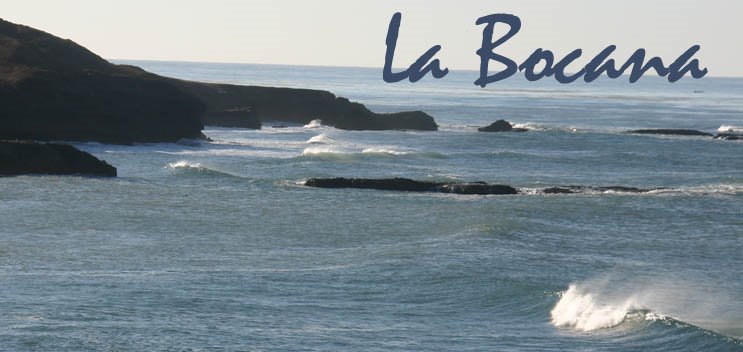Gordon and Opal (first American residents of La Bocana) recount finding La Bocana in the early 1960's:
At a party in Pasadena, we met Art Luczynski and casually mentioned our quest. He suggested looking at Puerto Santo Thomas, where he often camped. One sparkling April morning, Opal and I drove south on the San Diego freeway, bound for Baja and Puerto Santo Tomas.
Lightheaded, we breathed spring air and anticipated four days in new territory. The euphoria intensified as we passed Maneadero, ten miles south of Ensenada, into traffic-free country beyond the border influence. Only an occasional Mexican pick-up or aging sedan shared the two-lane road which turns off the highway and follows a fertile valley for seventeen miles
to the sea.
We were soon in an oak forest. Sunlight filtered through the leaves in dusty gossamer beams. Russet leaves were dappled with light. In a clearing, we passed the farm of our future friends Arturo, Maria, and Amalia. Their simple home appeared to have been built around an arched Window facing the road, as though the window had been there first and later the house had been built around it.
We left the oaks and bumped along the washboard road through green, yellow, and brown farm country in the valleys basin. The rich color was in sharp contrast to our preconception of a barren Baja. Small farms, corrals, and low farm houses complemented the rustic landscape. Overhead was blue sky and thick clouds.
In an hour or so, sea air cut through the road dust. From a knoll, we glimpsed ultramarine water and off-white sand The underground river running through the valley emerged to the surface, passing through the tulles to empty into the sea at La Bocana. Dense riverside growth ended on the brink of a sandy beach. Here, also, the road seemed to end. A road side sign in Spanish announced that this was Gomez country. Across the road from the sign was a small, unoccupied building which later was rebuilt to become Romulo’s store. Ahead, a hint of a road climbed straight up a steep, rocky hill. It looked formidable, if not impossible.
But where was Puerto Santo Tomas? Had we driven seventeen miles on the wrong bumpy road? After coming this far, we decided to chance the hill to see what lay beyond. A narrow
road at the summit followed the side of a precipitous mountain overlooking the sea. Further on, the road rose and disappeared over a mound.
"I'm not going over that hump without knowing what's on the other side,” I told Opal. "It might hide a drop-off to the ocean". I walked to the top of the mound. Ahead, near the tip of a distant point projecting far into the sea, were several buildings like rectangular, pallet-knife dabs of bright paint.
In between was a wide bay rimmed high cliff. "I think we've found our Port," I told Opal. In ten minutes we were there. As we drove in, two fishermen were repairing lobster traps and dogs dozed in the sun. An exuberant, weather smeared sign on the outside of the cantina read: "GOGE! GOGE! GOGE!" in elaborate letters bordered with giant musical notes. Loosely translated, they meant: "FUN! FUN! FUN!”
From the journals of Gordon and Opal - submitted by Marge. Thanks Marge!
Sunday, December 16, 2007
Subscribe to:
Post Comments (Atom)

No comments:
Post a Comment